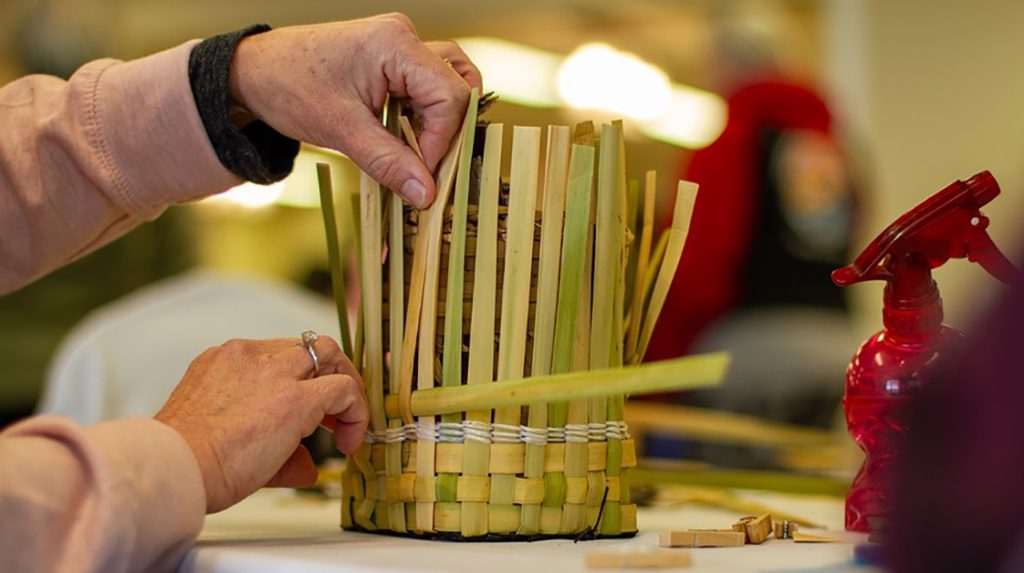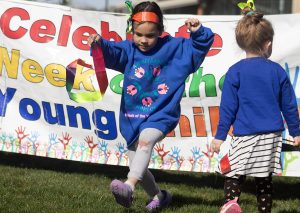By NIKA BARTOO-SMITH and JARRETTE WERK
Underscore News + Report for America
At a conference on the Oregon Coast hosted by the Portland All Nations Canoe Family, traditional weavers of all ages and skill levels shared stories and knowledge, stitch by stitch.
During the first week in March, snowflakes the size of dollar coins melted into the ocean waves and sandy shores at Lincoln City. Nearby, elders and community members from across the state and beyond convened at the inaugural Gathering of Native Weavers of Oregon.
In a room at the Chinook Winds Casino Resort overlooking the beach, the sounds of the waves hitting the shore and the rain pelting the windows blended together with the chimes of laughter. Nearly 150 people gathered to learn various weaving techniques from 12 Native American master weavers from across the Pacific Northwest. The event was organized and hosted by the Portland All Nations Canoe Family.
“The feel here is like family. It just feels like it was supposed to be here,” said Katy Holland, Confederated Tribes of Siletz Indians. “For the Portland Canoe Family to bring this to pass, it’s really special.”
The Confederated Tribes of Siletz Indians contributed by providing a conference room at the Chinook Winds Casino Resort and offering discounted rooms to attendees. Other tribes in Oregon also contributed, mostly by sponsoring travel for their elders and master weavers to attend.
Stephanie Ironheart, an enrolled member of the Cheyenne and Arapaho Tribes of Oklahoma, hopes this Gathering of Native Weavers of Oregon is just the beginning.
“We hope this is the first of many,” said Ironheart, cultural programming coordinator for the Portland All Nations Canoe Family. “It was very exciting that this came to be.”
From near and far
While some attendees came from an hour away or less, others commuted from as far away as Pendelton, Oregon and near the border with Canada in Lummi Nation, Washington. Many shared stories about braving weather extremes along the way.
In a large white van packed with elders from the Confederated Tribes of the Umatilla Indian Reservation (CTUIR), Carrie Campbell-Turk, Yellowhawk Tribal Health Center senior center coordinator, drove for more than six hours, much of it in the pouring rain.
Campbell-Turk, descendant of the Walla Walla Tribe and Turtle Mountain Band of Chippewa, brought with her a group of six elders, many of whom already take part in weekly basket weaving classes at Yellowhawk Tribal Health Center.
“It’s really important to get them out connecting,” Campbell-Turk said. “When you know where these people come from, it’s amazing to see them smile. Genuinely smile.”
The first night was filled with smiles as the elders sat in their rooms at Sea Gypsy Rentals, windows open listening to the healing sound of the waves, some seeing the ocean for the first time in decades.
Traveling from Lummi Nation, over 350 miles north, Floyd Warbus brought armloads of cedar bark he had harvested the year prior. The vibrant greens and blues of his Seattle Seahawks Native sweater vest stood out among the natural wood colors of the cedar bark he prepared to be made into cedar headbands. He split the bark into smaller sections, and then placed the strips into a red bucket to soak.
For Warbus, this event marked his first time leaving Lummi Nation since his wife passed away last March.
He learned how to pull cedar at a young age, but did not start weaving until later in life, learning from his mother and wife. Around the room, Warbus pointed to a few different women in cedar fedoras, made through the instruction of his wife.
“My mom taught me how to do this, my wife taught me how to do this,” Warbus said, working the long strips of cedar between his hands. “But I’m doing this all by myself now.”
Sharing knowledge
Inside a gray tub at Siletz weaver Laurae Hughes’ table, thin strips of cedar sat soaking in water. She instructed participants in her weaving class to choose four strips to form the base of a small basket and three thinner strips to weave into a pattern.
The earthy smell of wet wood permeated the air as Hughes diligently went around the table to help each participant create their very own cedar container.
Dozens of tattoos adorn Hughes’ arms, telling the story of where she comes from. On her left arm is a portrait of Lakota chief Hollow Horn Bear, based on a poster her father drew. Basket patterns snake across her forearms and biceps and bees hint at her life as a beekeeper.
Hughes pointed to a raven tattoo on her arm, a creature she identifies with. Like the raven, Hughes has been called both a wise one and a trickster.
Through the wisdom she has gained learning to harvest, process and weave materials such as cedar, Hughes gives back to her Siletz community by teaching others to carry on that knowledge, especially during each summer’s Siletz Culture Camp. She originally taught herself to weave while living on the east coast, traveling back and forth to harvest the materials from her traditional homelands.
“I feel like it’s my obligation or my duty and my honor to be able to teach,” Hughes said. “I had to learn from 3,000 miles away. So guess what? Now you got to know. I have to teach you.”
Healing through the generations
Two young Siletz women in ribbon skirts, Jeidah DeZurney, 25, and Savanna Rilatos, 26, sat at their table working on small cedar baskets that would eventually be strung on braids of cedar, turned into necklaces.
The baskets grew taller in their hands with each row of cedar carefully woven into place. Meanwhile, the two women reflected on the importance of the conference.
“There is just incredible intergenerational learning going on,” said Rilatos. “So much storytelling goes on and it’s so important because there’s so much history being passed on during the process.”
She said she is excited to go gathering with her two-year-old son. Eventually, she will teach him how to weave as he grows in hopes that he too will one day do his part to keep the tradition of weaving alive.
As participants completed their carefully crafted weaving projects, instructors raised the finished piece into the air. Each one met with an eruption of applause from around the room.
Projects included: cattail baskets, yarn baskets, wool bags, wool headbands, pine needle baskets, beargrass bracelets, cedar baskets, cedar jewelry and a soap root brush.
Sitting together weaving, people shared stories and knowledge. An auntie told her niece about a great aunt who she remembers weaving baskets. An elder shared her story about reconnecting to her Siletz heritage after growing up in a boarding school. A grandma talked about how excited she was to teach her grandson how to weave.
“When you do these things, it’s healing for generations and it sends good medicine clear down to three, four generations down the road,” Carrie Campbell-Turk said.
Underscore is a nonprofit collaborative reporting team in Portland focused on investigative reporting and Indian Country coverage. It is supported by foundations, corporate sponsors and donor contributions. Follow Underscore on Facebook and X.




